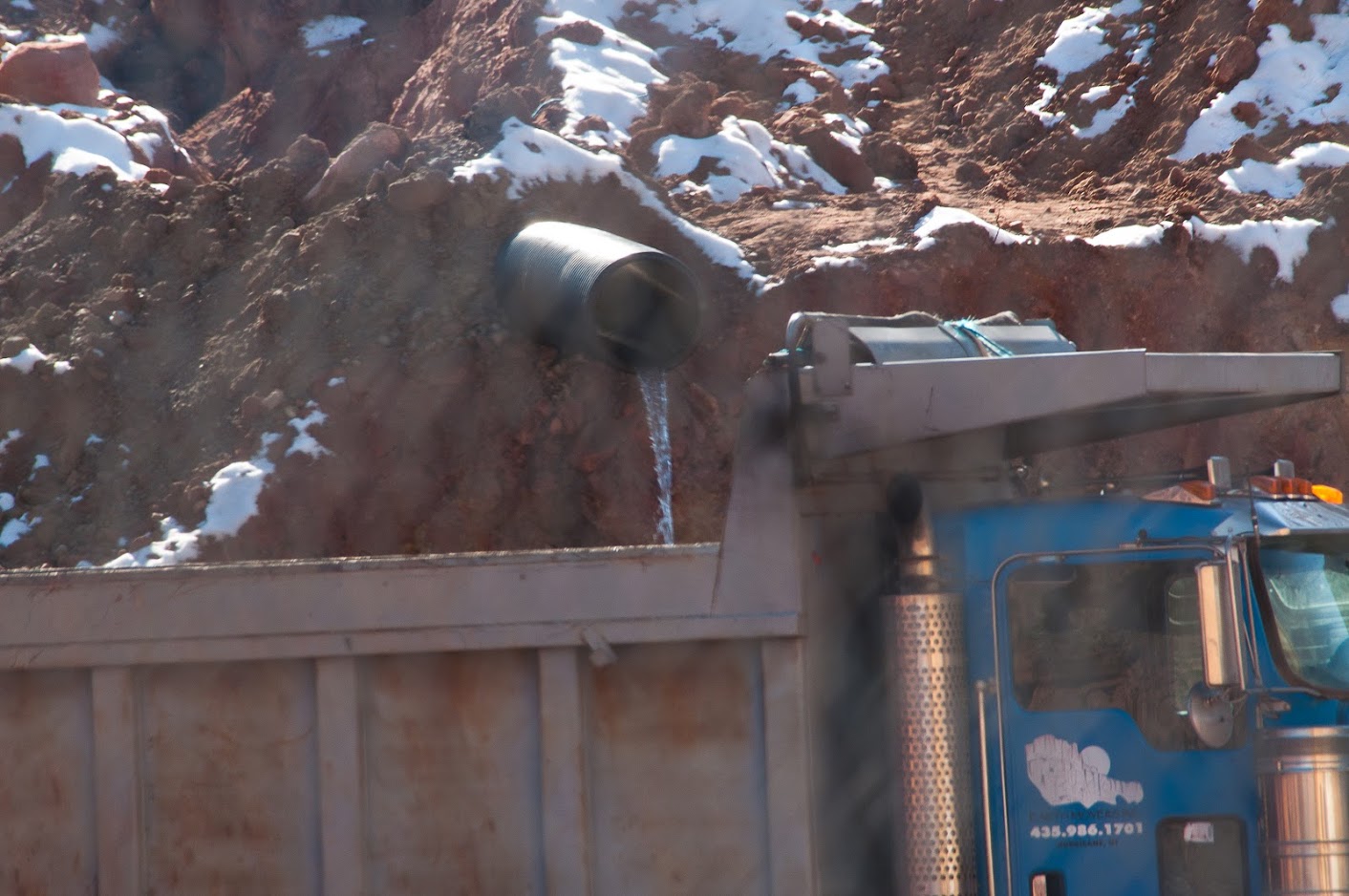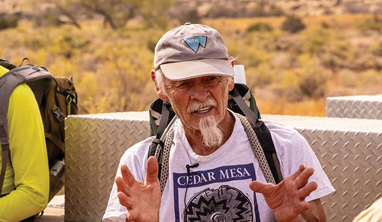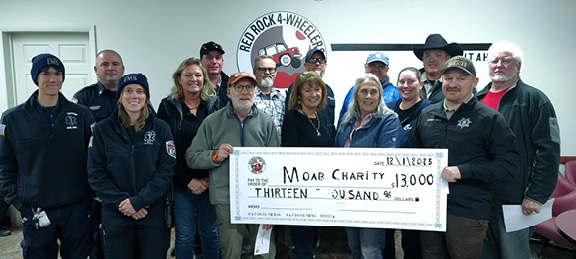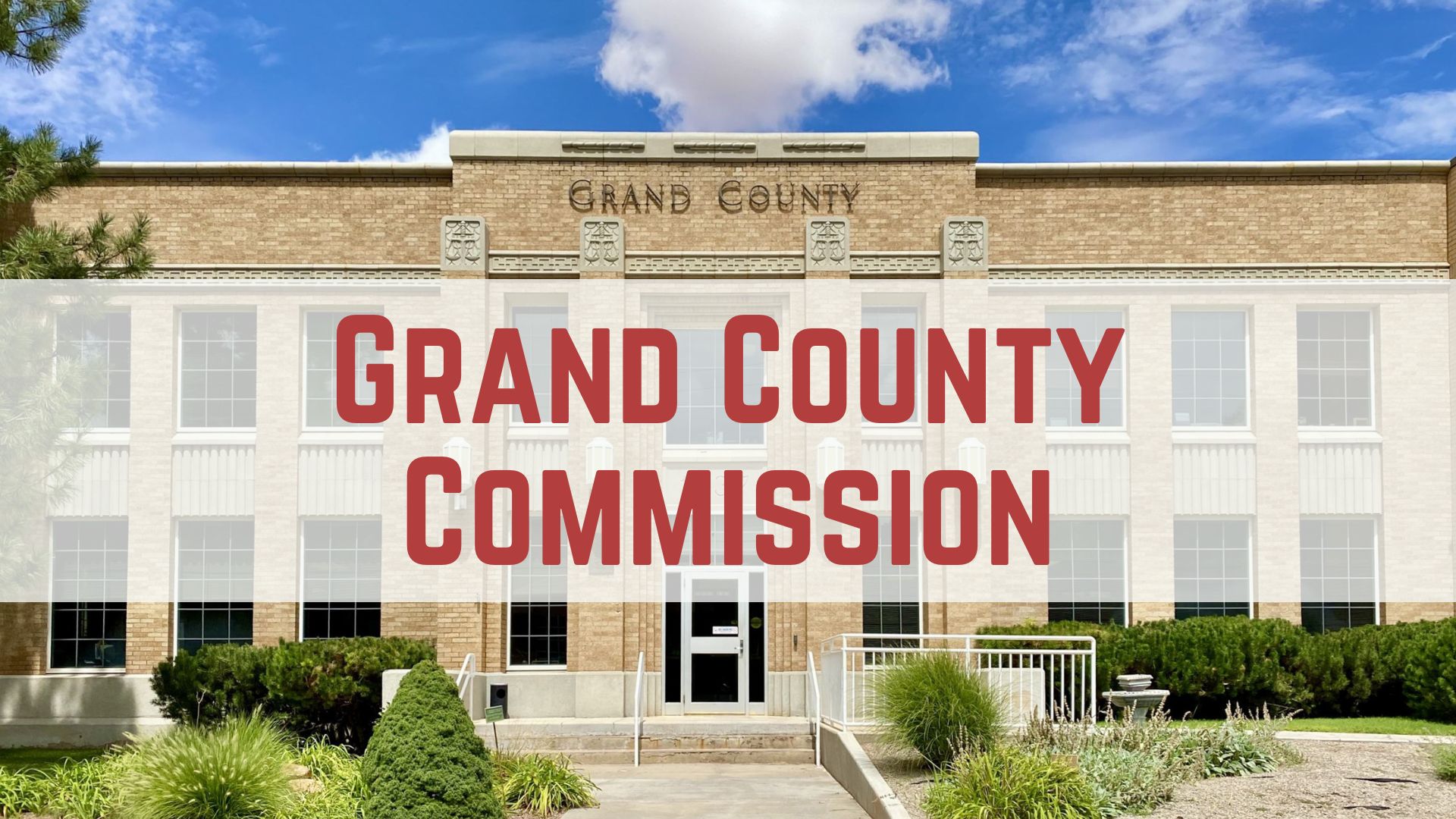Some information may be outdated.
If you’ve traveled past the Wingate by Wyndham hotel construction site in recent months, you may have noticed water flowing out of the hillside behind the new building on South U.S. Highway 191.
County officials say that spring water behind the site began to pour out of an embankment late this summer, after construction crews dug into a slope that’s immediately behind the new structure. Based on that determination, they ordered the project developer last week to come up with an amended drainage plan that resolves the problem.
“The fact that this development exposed subsurface water that is now flowing in a direction that we weren’t seeing previously … means the developer now has to deal with it,” Grand County Community and Economic Development Director Zacharia Levine told the Moab Sun News.
At the county’s request, the project’s developer says it’s studying the history of the site in order to better understand hydrological patterns there.
“We’re trying to document historically where the water went, and how often it went there, et cetera,” project representative and partner Alan Melchior said.
But those studies will likely take a few weeks to complete, he said, and until questions about drainage patterns have been answered, neighboring property owners shouldn’t draw their own conclusions about the issue.
“I don’t think they know what they’re talking about, because nobody has studied it yet,” Melchior said.
However, some of the longtime neighbors say that the water from the Silver Holyoak Spring is now being diverted into a drainage ditch that runs through privately owned properties on the opposite side of the highway. That diversion, they say, is creating drainage problems where none existed before.
Former Moab City Council member Kirstin Peterson, who co-owns Rim Tours at 1233 S. U.S. Highway 191, has owned her property since 1994. The only water that’s ever flowed down the ditch in that time, she said, is stormwater runoff.
When the hotel construction crews began to excavate the Wyndham property and uncovered the spring, Peterson said, they sent the subsurface water through the ditch via a feeder pipe that runs underneath the highway. Since that time, she said, the water has been flowing constantly through the ditch.
Peterson told the Grand County Council that the previous property owners used a minimal amount of water for irrigation, and any remainder of that water traveled down another ditch on the west side of the highway.
“And none of that has ever come over onto our side, where this ditch is,” she said during the council’s regular meeting on Tuesday, Dec. 4.
According to Peterson, the ditch on the east side of the highway is located entirely on private property, and the property owners whose land faces Wagner Avenue own each section of it.
“My property, unfortunately, is on the downhill side of the ditch, and being closest to the highway, when the ditch overflows, it floods my property,” Peterson said. “We do our best to maintain the ditch along our property — even though we don’t own it — but obviously, there’s only so much we can do.”
Peterson asked county council members to consider who would be liable if and when any related flood damage occurred.
“If the county has approved of the plan that diverts the spring water, I believe it’s going to fall back on the county,” she said.
She also questioned who will be responsible for maintaining the drainage ditch, now that water is flowing continuously down it, and she asked if any storm runoff from the Wyndham property will be directed into the ditch.
“I would like assurance that these questions will be answered … before the hotel is completed,” Peterson said.
To resolve those questions and others, Levine met with project representatives last week, leading his office to seek the drainage plan amendments.
Levine doesn’t know offhand exactly how much water is currently flowing into the ditch, but it’s believed to be a substantial amount.
“The reports and our observations suggest that there is water flowing in there continuously,” Levine said.
Before any construction work on the project began, Levine said, crews excavated five test pits under the building’s footprint to depths of 10 feet. But they didn’t encounter any groundwater during those tests, so the project’s original drainage plan did not account for any subsurface water that is now flowing from the property, he said.
Without having the benefit of a project engineer by his side, Melchior said he’s not sure that Levine’s comments about the test pits’ location are correct. But he said that water has been on the Wyndham property historically, and he noted that county officials signed off on the developer’s original plan to manage it.
“In layman’s terms, our drainage plan — which was approved by the county — didn’t change the amount of runoff after the development, versus before the development,” Melchior said. “Otherwise, it would not have been approved by the county.”
Southeastern Utah Division of Water Rights (DWRi) Engineer Marc Stilson said the Silver Holyoak Spring has water rights claims that date back to 1886. In 1960, a water right to the spring was filed with its uses listed as four residences and five head of cattle. The water right, which is listed on the property’s deed, was conveyed earlier this year to Salt Lake City-based View Gate Development, LLC, from The Holyoak Family Trust.
Stilson said several people involved in the issue have called the Utah Division of Water Rights recently to ask questions.
He refers people who inquire about potential impacts to their properties to Utah Code 73-1-8, which states “the owner of any ditch … shall maintain it to prevent waste of water or damage to the property of others.”
“THESE THINGS DO HAPPEN WITH SLOPE DEVELOPMENT”
Peterson said it’s her understanding that the constant stream flow is affecting other property owners in the area.
Ultimately, she said, it’s unclear to her where the remainder of storm runoff from the Wyndham property will end up.
“I was told that there would be a retention basin on the property, but all I’ve observed is a substantial amount of infrastructure being put in, which leads to the pipe that feeds this ditch,” she said.
One of those property owners — Wagner Avenue resident Jesse Marshall — bought the first permitted earthbag home in Utah, which Alison Kennedy built on a man-made hill.
It wasn’t until the most recent rainy season had already passed, he said, that he noticed water was still coming out of the culvert. His curiosity, he said, led him to the hotel property.
“It came all of the way down through all of this culvert, and it basically emptied out onto my property before it hit the creek,” he told the county council.
It reached the point that a shallow “lake” formed over most of the open area on his property, he said, and then started to dissolve the hill on which his house sits.
As his concerns about the water grew, Marshall said he dug a trench through a neighbor’s property to divert it, risking the possibility of creating some animosity with them.
“If your neighbor was into your property digging a trench, a lot of folks just aren’t happy about that kind of stuff,” Marshall said. “Luckily, my neighbors were understanding of what I was doing and why I was doing it. Unfortunately, one of the side effects of the trench that I dug to save my property was that now my neighbor will no longer be able to access their property to just go right over to the entrance.”
In the short term, Marshall said, his problem has been solved.
“My property is no longer flooding, but like I say, I’ve created problems for my neighbor, and the more folks that I talk to on Wagner Avenue, there are a lot of folks that are having problems with this water,” he said. “There is a concern that this waterway will be saturated 100 percent of the year, and when the floods do come, I think that the intensity of the water washing down is going to be far greater.”
While the preconstruction tests failed to predict just how much subsurface water is coming from the spring, Levine said those flows are not unusual.
“These things do happen with slope development,” he said.
Moving forward, Levine’s office expects to receive the developer’s amended drainage plan no later than Friday, Dec. 14.
“If it’s not sufficient at that point, we will request additional changes,” he said.
But Melchior said he’s uncertain that his team can meet the county’s deadline.
“We said we would try to get this done, but we want to make sure that it’s done accurately, and we’re sure that the county wants it done accurately, as well,” Melchior said. “We’re not sure that can be done in one week … (But) we will do our best.”
The online version of this article was updated on Dec. 18 to say that one of the property owners, Wagner Avenue resident Jesse Marshall, bought the first permitted earthbag home in Utah, which Alison Kennedy built on a man-made hill. The article that appeared in last week’s print edition erroneously reported that Jesse Marshall built the earthbag home.
Neighbors say water from project is impacting properties; developer says further study is needed
“The fact that this development exposed subsurface water that is now flowing in a direction that we weren’t seeing previously … means the developer now has to deal with it.”
Appreciate the coverage? Help keep local news alive.
Chip in to support the Moab Sun News.





